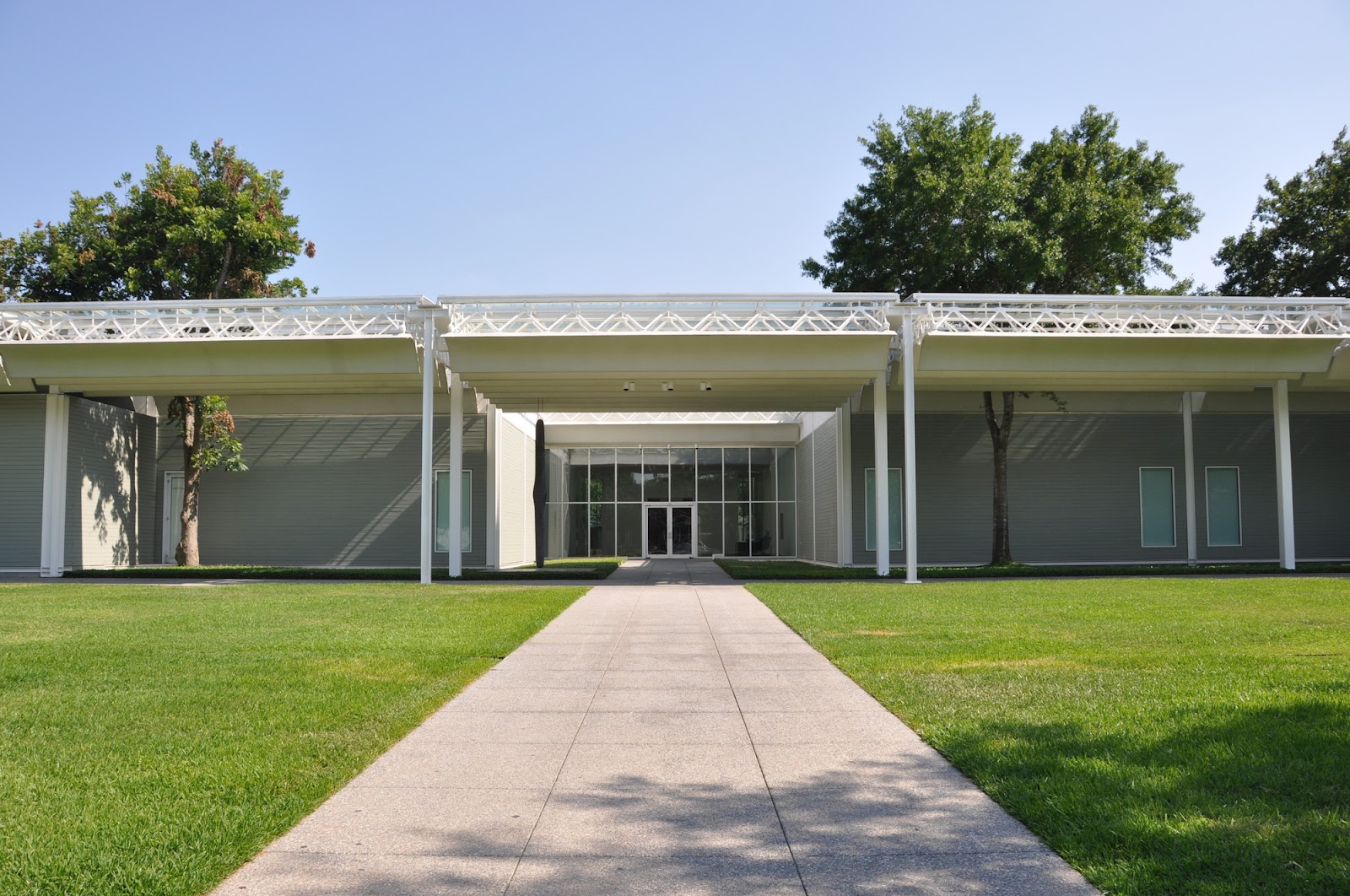The Menil Collection: Houston’s Hidden Gem of Art, Architecture, and Culture
In a city known for its space industry, diverse cuisine, and bustling business centers, Houston’s Montrose neighborhood offers a quieter, more contemplative space—home to The Menil Collection. Located at 1533 Sul Ross Street, this free museum is not only one of the most unique art spaces in Texas but a cultural treasure on the national stage. With its serene campus, world-class collection, and a vision rooted in accessibility and human connection, The Menil Collection stands as a testament to the transformative power of art.

A Visionary Beginning
The Menil Collection was founded by French-American philanthropists Dominique and John de Menil. Arriving in Houston after fleeing Nazi-occupied France, the couple brought with them a deep appreciation for the arts and a belief that art could serve as a bridge between cultures, ideologies, and generations. Their personal collection of art—amassed over decades and rooted in their humanist values—would later form the foundation of the museum.
The museum officially opened to the public in 1987. Unlike most major institutions, The Menil Collection was designed from the ground up to be open and approachable. Admission has always been free, reflecting the de Menils’ belief that art should be accessible to all, regardless of background or income.
Architectural Simplicity and Subtlety
Renzo Piano, the Pritzker Prize-winning architect, was commissioned to design the museum. His goal was to create a building that would not overshadow the artwork it housed. The result is a light-filled, minimalist structure clad in pale gray clapboard siding that blends harmoniously with the residential neighborhood around it.
Rather than the imposing facades seen at many urban museums, The Menil Collection invites visitors with an understated presence. Skylights and a unique louvered roof system allow soft natural light to filter into the galleries, creating a gentle, contemplative environment ideal for engaging with art on a personal level.
The Collection: Vast, Varied, and Vital
The Menil Collection is home to more than 17,000 pieces, spanning from ancient times to the modern day. While its scope is vast, the museum’s layout avoids overwhelming visitors. Works are displayed in carefully curated groupings that invite deep reflection.
- Surrealism and Dada: One of the museum’s signature strengths is its collection of surrealist art. Visitors can view iconic works by Max Ernst, Marcel Duchamp, René Magritte, and Yves Tanguy. These works—often strange, dreamlike, and symbolic—reflect the de Menils’ fascination with the subconscious mind and the boundaries of rationality.
- Modern and Contemporary Works: The Menil is also known for its 20th-century masterpieces. Pieces by artists like Mark Rothko, Jackson Pollock, and Andy Warhol speak to the evolution of modern art. Each gallery encourages a dialogue between the viewer and the artwork, often without the distraction of heavy labels or guided interpretation.
- Byzantine and Medieval Art: From religious icons to ancient manuscripts, this section reveals the sacred roots of visual expression. The works, many of them centuries old, are displayed with reverence, encouraging visitors to contemplate their significance beyond their historical value.
- African, Oceanic, and Indigenous Art: With masks, totems, tools, and ceremonial objects from across the globe, this portion of the collection highlights the cultural breadth of human creativity. Rather than exoticizing these objects, the museum presents them as equally vital to the narrative of art history.
- Antiquities: Ranging from Egyptian sculptures to Roman glasswork and Greek pottery, these pieces connect today’s viewers with the ancient world, bridging time and geography.
A Campus of Art and Reflection
What makes The Menil Collection even more extraordinary is its surrounding campus—a collection of satellite buildings and open green spaces that extend the experience beyond the museum walls.
- Cy Twombly Gallery: A separate space dedicated to the late American artist, this gallery houses some of Twombly’s most ambitious works. Designed with the artist’s input, the building provides a quiet setting that mirrors his contemplative visual language.
- The Menil Drawing Institute: Opened in 2018, this is the first facility in the United States devoted solely to the collection, study, and exhibition of modern and contemporary drawings. Its sleek, modern architecture contrasts with the main building but maintains the campus’s commitment to natural light and openness.
- Richmond Hall (Dan Flavin Installation): Just a short walk away is a permanent installation of Dan Flavin’s fluorescent light sculptures. The room-size work pulses with color and minimalism, creating an immersive experience in space, light, and perception.
- The Byzantine Fresco Chapel: This building originally housed rare frescoes from Cyprus and now functions as a spiritual art space with rotating contemporary installations. It remains a sacred architectural presence on the Menil campus.
- Outdoor Experience: The Menil neighborhood itself is part of the museum’s intentional design. Shaded lawns and pedestrian-friendly sidewalks connect all buildings, while Menil-gray-painted bungalows house research facilities and administrative offices. The quiet setting feels miles away from the urban rush of downtown Houston, even though it’s just minutes away.
Commitment to Community and Education
The Menil Collection is not just a museum—it’s a learning institution and cultural catalyst. Educational programs include school tours, community workshops, artist talks, and lecture series. The museum actively collaborates with local organizations and universities, ensuring that its influence reaches beyond its walls.
It also embraces contemporary conversations through temporary exhibitions and artist residencies that often tackle social justice, identity, and political themes. This keeps the museum relevant and responsive to today’s world, while still grounded in its founders’ values.
Dining, Shopping, and Nearby Attractions
While The Menil Collection itself doesn’t include a restaurant or café, the surrounding Montrose area offers abundant dining options. Local favorites like Common Bond Café, Brasil, and Agora Coffee are all within walking distance, making it easy to pair a museum visit with lunch or coffee.
Art lovers will also enjoy visiting the nearby Rothko Chapel, an ecumenical space featuring Mark Rothko’s murals in a setting meant for meditation and reflection. Other nearby attractions include the Houston Center for Photography, the Contemporary Arts Museum Houston, and the University of St. Thomas campus.
Planning Your Visit
The Menil Collection is open Wednesday through Sunday from 11 AM to 7 PM and is always free to the public. Parking is available along neighborhood streets, and the campus is bike- and pedestrian-friendly. Its accessibility, both physical and financial, makes it one of the most welcoming museums in the country.
Conclusion: A Cultural Gift to Houston and the World
The Menil Collection is not just an art museum—it is a living embodiment of a philosophy. It champions the idea that art should be for everyone, not just the elite. It values contemplation over spectacle, and depth over scale. In doing so, it stands as one of Houston’s—and America’s—most important cultural institutions.
Whether you’re a seasoned art enthusiast or someone new to museum-going, a visit to 1533 Sul Ross Street will leave you moved, inspired, and deeply connected to the creative legacy of humanity. The Menil Collection is not a stop on the map—it’s a destination for the soul.
Learn more about the Cybersecurity Company we offer
Driving Directions to I.T. Matters, Inc. | Managed IT Services & IT Support Company Houston, Texas From This POI:
Driving Directions To The Next POI
